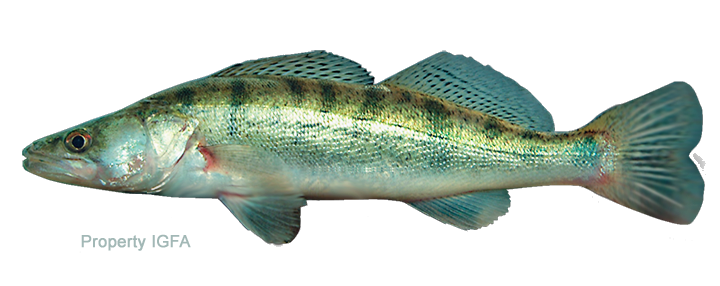Game Fish Identification Reference Guides
Zander
(Sander lucioperca)
(Sander lucioperca)

(Linnaeus 1758); PERCIDAE FAMILY; also called pike perch, lucioperca, sandre, abborrfisk, kuha
This species is native to eastern and central Europe, Sweden and Finland and western Asia. It has been introduced into several other European countries, including England and is rapidly extending its range. This species has depleted stocks of native fish in some areas where it has been introduced for angling.
The zander is very similar in body form and coloration to its close relative, the walleye, of North America. It is a slender fish with a pointed snout and a mouth with large, fang-like teeth. In large fish the upper jaw extends well beyond the center of the eye. The first and second dorsal fins are separate and both the dorsal and caudal fins have dark spots. The dark elongated spots on the dorsal fins form broken stripes. Color varies from greenish-gray to brown on the back and sides becoming lighter on the lower sides and white on the belly.
The Zander is a predatory species most abundant in large lakes and lowland rivers, preferring cloudy water and avoiding weed-beds. It hunts most actively at dawn and dusk, remaining inactive at other times, usually close to the bottom. While young Zanders are found in small schools with larger individuals becoming solitary.
The Zanders are not spectacular fighters, but due to their ability to offer a dogged resistance, they are valuable sporting fish. Methods of fishing similar to those used for northern pike but with lighter tackle. Most anglers freeline or ledger live or dead baits. Others find float fishing or using lures effective. In inland Europe, the Zander is an important food fish
This species is native to eastern and central Europe, Sweden and Finland and western Asia. It has been introduced into several other European countries, including England and is rapidly extending its range. This species has depleted stocks of native fish in some areas where it has been introduced for angling.
The zander is very similar in body form and coloration to its close relative, the walleye, of North America. It is a slender fish with a pointed snout and a mouth with large, fang-like teeth. In large fish the upper jaw extends well beyond the center of the eye. The first and second dorsal fins are separate and both the dorsal and caudal fins have dark spots. The dark elongated spots on the dorsal fins form broken stripes. Color varies from greenish-gray to brown on the back and sides becoming lighter on the lower sides and white on the belly.
The Zander is a predatory species most abundant in large lakes and lowland rivers, preferring cloudy water and avoiding weed-beds. It hunts most actively at dawn and dusk, remaining inactive at other times, usually close to the bottom. While young Zanders are found in small schools with larger individuals becoming solitary.
The Zanders are not spectacular fighters, but due to their ability to offer a dogged resistance, they are valuable sporting fish. Methods of fishing similar to those used for northern pike but with lighter tackle. Most anglers freeline or ledger live or dead baits. Others find float fishing or using lures effective. In inland Europe, the Zander is an important food fish













